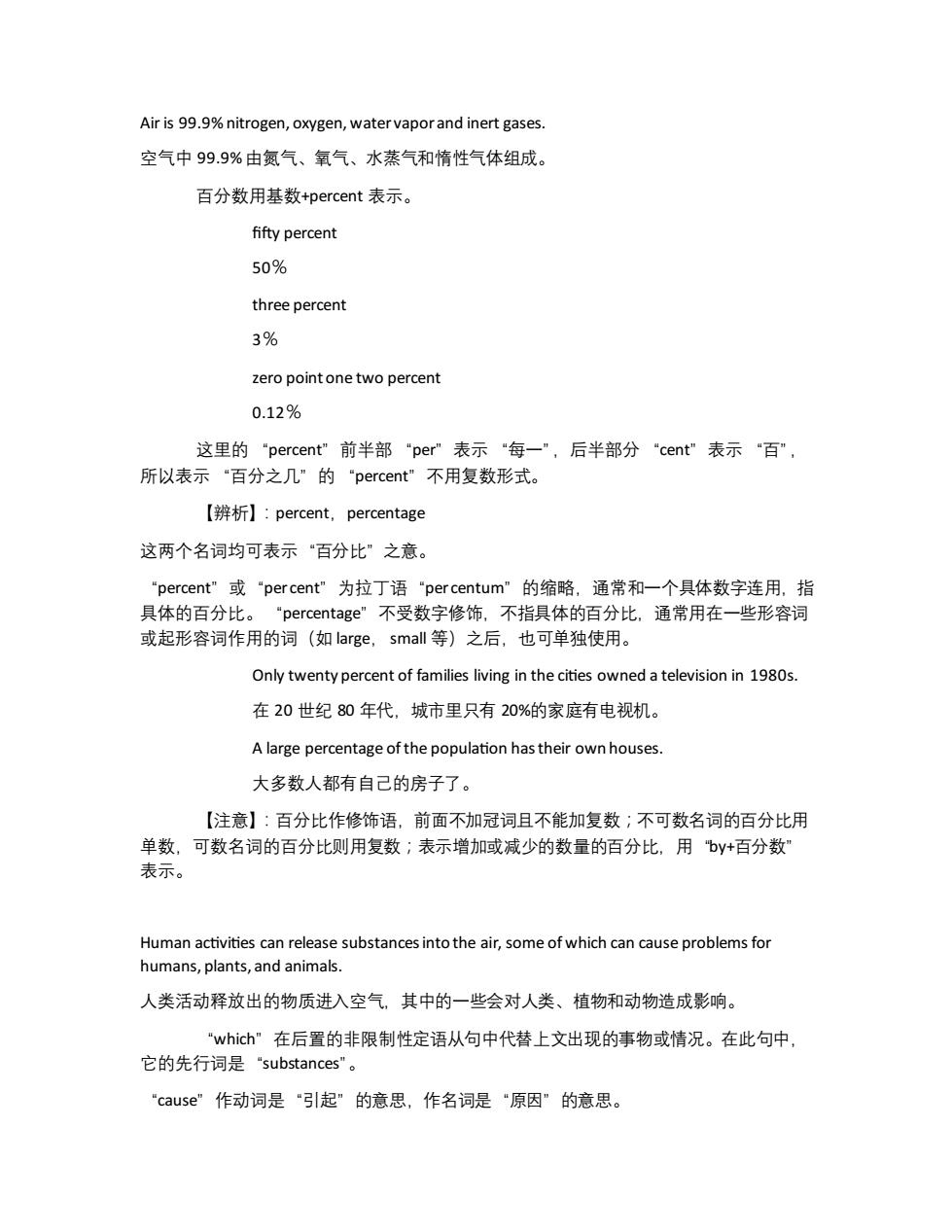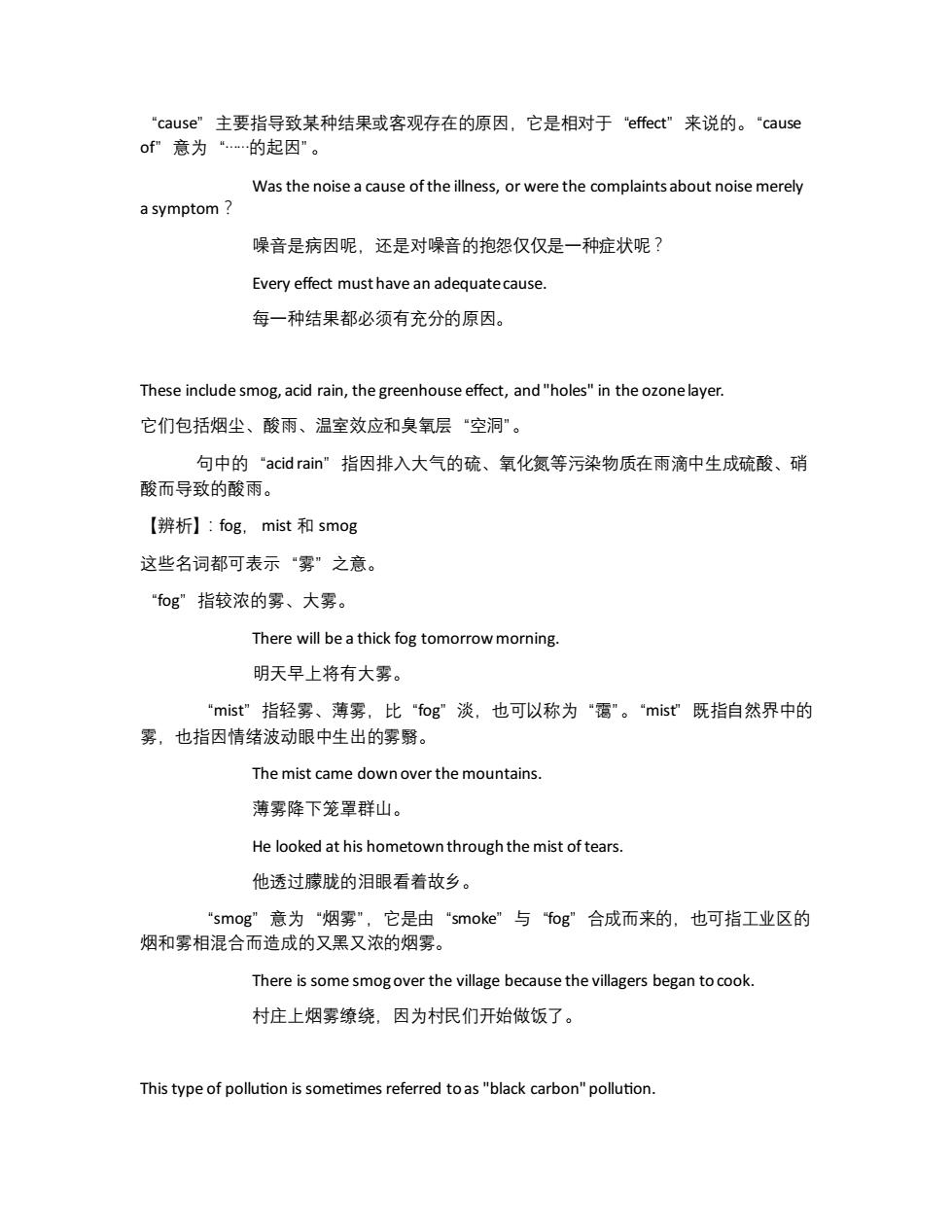
Air is 99.9%nitrogen,oxygen,watervapor and inert gases. 空气中99.9%由氮气、氧气、水蒸气和惰性气体组成。 百分数用基数+percent表示。 fifty percent 50% three percent 3% zero pointone two percent 0.12% 这里的“percent"前半部per”表示“每一',后半部分“cent”表示“百" 所以表示“百分之几:的“percent'"不用复数形式。 【辨析】:percent,.percentage 这两个名词均可表示“百分比”之意。 "percent”或"per cent"”为拉丁语"per centum”的缩略.通常和-个具体数字连用.指 具体的百分比。“percentage'”不受数字修饰,不指具体的百分比,通常用在一些形容词 或起形容词作用的词(如large,smal等)之后,也可单独使用。 Only twenty percent of families living in the cities owned a television in 1980s. 在20世纪80年代,城市里只有20%的家庭有电视机。 A large percentage of the population has their own houses 大多数人都有自己的房子了。 【注意】:百分比作修饰语,前面不加冠词且不能加复数;不可数名词的百分比用 单数,可数名词的百分比则用复数;表示增加或减少的数量的百分比,用by+百分数” 表示。 Human activities can release substances into the air,some of which can cause problems for humans,plants,and animals 人类活动释放出的物质进入空气,其中的一些会对人类、植物和动物造成影响。 "which”在后置的非限制性定语从句中代替上文出现的事物或情况。在此句中 它的先行词是"substances'"。 cause'”作动词是引起”的意思,作名词是“原因”的意思
Air is 99.9% nitrogen, oxygen, water vapor and inert gases. 空气中 99.9% 由氮气﹑氧气﹑水蒸气和惰性气体组成。 百分数用基数+percent 表示。 fifty percent 50% three percent 3% zero point one two percent 0.12% 这里的“percent”前半部“per”表示“每一”,后半部分“cent”表示“百”, 所以表示“百分之几”的“percent”不用复数形式。 【辨析】:percent,percentage 这两个名词均可表示“百分比”之意。 “percent”或“per cent”为拉丁语“per centum”的缩略,通常和一个具体数字连用,指 具体的百分比。“percentage”不受数字修饰,不指具体的百分比,通常用在一些形容词 或起形容词作用的词(如 large,small 等)之后,也可单独使用。 Only twenty percent of families living in the cities owned a television in 1980s. 在 20 世纪 80 年代,城市里只有 20%的家庭有电视机。 A large percentage of the population has their own houses. 大多数人都有自己的房子了。 【注意】:百分比作修饰语,前面不加冠词且不能加复数;不可数名词的百分比用 单数,可数名词的百分比则用复数;表示增加或减少的数量的百分比,用“by+百分数” 表示。 Human activities can release substances into the air, some of which can cause problems for humans, plants, and animals. 人类活动释放出的物质进入空气,其中的一些会对人类﹑植物和动物造成影响。 “which”在后置的非限制性定语从句中代替上文出现的事物或情况。在此句中, 它的先行词是“substances”。 “cause”作动词是“引起”的意思,作名词是“原因”的意思

“cause'主要指导致某种结果或客观存在的原因.它是相对于"effect”来说的。"cause of意为…的起因”。 Was the noise a cause of the illness,or were the complaints about noise merely a symptom? 噪音是病因呢,还是对噪音的抱怨仅仅是一种症状呢? Every effect must have an adequatecause. 每一种结果都必须有充分的原因。 These include smog,acid rain,the greenhouse effect,and"holes"in the ozonelayer. 它们包括烟尘、酸雨、温室效应和臭氧层“空洞”。 句中的"acid rain”指因排入大气的硫、氧化氮等污染物质在雨滴中生成硫酸、硝 酸而导致的酸雨。 【辨析】:fog,mist和smog 这些名词都可表示“雾”之意。 fog指较浓的雾、大雾。 There will be a thick fog tomorrow morning. 明天早上将有大雾。 "mist”指轻雾、薄雾.比“fog”淡.也可以称为“霭”。“mist既指自然界中的 雾,也指因情绪波动眼中生出的雾翳。 The mist came down over the mountains. 薄雾降下笼罩群山。 He looked at his hometown through the mist of tears. 他透过朦胧的泪眼看着故乡。 "smog”意为“烟雾",它是由"smoke'与fog”合成而来的,也可指工业区的 烟和雾相混合而造成的又黑又浓的烟雾。 There is some smogover the village because the villagers began to cook. 村庄上烟雾缭绕.因为村民们开始做饭了。 This type of pollution is sometimes referred to as"black carbon"pollution
“cause”主要指导致某种结果或客观存在的原因,它是相对于“effect”来说的。“cause of”意为“……的起因”。 Was the noise a cause of the illness, or were the complaints about noise merely a symptom? 噪音是病因呢,还是对噪音的抱怨仅仅是一种症状呢? Every effect must have an adequate cause. 每一种结果都必须有充分的原因。 These include smog, acid rain, the greenhouse effect, and "holes" in the ozone layer. 它们包括烟尘﹑酸雨﹑温室效应和臭氧层“空洞”。 句中的“acid rain”指因排入大气的硫、氧化氮等污染物质在雨滴中生成硫酸、硝 酸而导致的酸雨。 【辨析】:fog,mist 和 smog 这些名词都可表示“雾”之意。 “fog”指较浓的雾、大雾。 There will be a thick fog tomorrow morning. 明天早上将有大雾。 “mist”指轻雾、薄雾,比“fog”淡,也可以称为“霭”。“mist”既指自然界中的 雾,也指因情绪波动眼中生出的雾翳。 The mist came down over the mountains. 薄雾降下笼罩群山。 He looked at his hometown through the mist of tears. 他透过朦胧的泪眼看着故乡。 “smog”意为“烟雾”,它是由“smoke”与“fog”合成而来的,也可指工业区的 烟和雾相混合而造成的又黑又浓的烟雾。 There is some smog over the village because the villagers began to cook. 村庄上烟雾缭绕,因为村民们开始做饭了。 This type of pollution is sometimes referred to as "black carbon" pollution